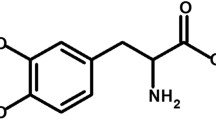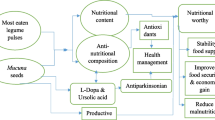Abstract
Genus Mucuna has tremendous value in the Indian Ayurveda, and the species have been used for the management of diseases including Parkinson’s disease. Unfortunately, species other than M. pruriens are neglected for scientific investigation. In the present study, quantification of anti-Parkinson’s drug l-DOPA content using HPLC from eighteen different Mucuna samples from Indian subcontinent comprising nine species, five varieties of M. pruriens and a commercial Mucuna powder from Zandu Pharmaceutical Ltd. (MZP) is carried out. Seeds of eighteen Mucuna accessions were analyzed for l-DOPA content using RP-HPLC. The l-DOPA content from different samples is compared with commonly used M. pruriens var utilis. Moreover, possible correlation of protein and carbohydrate with l-DOPA synthesis is hypothesized. The authors found varying l-DOPA content in different species and varieties; and higher l-DOPA containing species were M. macrocarpa (11.6 ± 0.21%), M. sanjappae (10.81 ± 0.2%) and M. atropurpurea (10.80 ± 0.1%). Some of the M. pruriens accessions contained higher level of l-DOPA including M. pruriens var hirsuta (10.2 ± 0.15%), M. pruriens var utilis (Manipur) (9.9 ± 0.15%) and M. pruriens var pruriens (Aurangabad) (9.41 ± 0.07 and 9.5 ± 0.12%). The species, M. gigentea had the lowest l-DOPA content (3.68 ± 0.17%). The strong correlation between l-DOPA and carbohydrate content (R2 = 0.7997) was observed, whereas insignificant correlation (R2 = 0.0277) between protein and l-DOPA content was observed. Higher anti-Parkinson’s drug l-DOPA-containing species were found from India which can be explored further for better extraction of this immense drug. The present study opens a new avenue for metabolite modeling in plant for commercial production of l-DOPA at industrial level.





Similar content being viewed by others
References
Jadiya P, Khan A, Sammi S, Kaur S, Mir S, Nazir A (2011) Anti-Parkinsonian effects of Bacopa monnieri: insights from transgenic and pharmacological Caenorhabditis elegans models of Parkinson’s disease. Biochem Biophys Res Commun 413(4):605–610
Thomas B, Flint Beal M (2007) Parkinson’s disease. Hum Mol Genet 16:183–194
Inamdar SA, Surwase SN, Jadhav SB, Bapat VA, Jadhav JP (2013) Statistically optimized biotransformation protocol for continuous production of l-DOPA using Mucuna monosperma callus culture. SpringerPlus 2:570–578
Prakash J, Yadav SK, Chouhan S, Singh SP (2013) Neuroprotective role of Withania somnifera root extract in maneb–paraquat induced mouse model of parkinsonism. Neurochem Res 38(5):972–980
Politisa M, Niccolinia F (2014) Serotonin in Parkinson’s disease. Behav Brain Res 277:136–145
Guggenheim Z (1913) Physiol Chem 88:276
Damodaran M, Ramaswamy R (1937) Isolation of l-3: 4-dihydroxyphenylalanine from the seeds of Mucuna pruriens. Biochem J 31(12):2149
Kofman O (1971) Treatment of Parkinson’s disease with l-DOPA: a current appraisal. Can Med Assoc J 104(6):483–487
Vijayakumari K, Siddhuraju P, Janardhanan K (1996) Effects of different post-harvest treatments on anti-nutritional factors in seeds of the tribal pulse, Mucuna pruriens (L.) DC. Int J Food Sci Nutr 47(3):263–272
Aguiyi JC, Igweh AC, Egesie UG, Leoncini R (1999) Studies on possible protection against snake venom using Mucuna pruriens protein immunization. Fitoterapia 70(1):21–24
Amin KMY, Khan MN, Hakim SZR et al (1996) Sexual function improving effect of Mucuna pruriens in sexually normal male rats. Fitoterapia 67(1):53–58
Lorenzetti F, Mac Issac S, Arnason JT, Awang DVC, Buckles D (1998) The phytochemistry, toxicology and food potential of velvet bean (cow(h)age, cowitch) (Mucuna adans spp., Fabaceae). In: Buckles D, Eteka A, Osiname O, Galiba M, Galino G (eds) Cover crops in West Africa contributing to sustainable agriculture. IDRC, Ottawa, pp 67–84
Brilliant MH (2015) Mining retrospective data for virtual prospective drug repurposing: l-DOPA and age-related macular degeneration. Am J Med 129(3):292–298
Koyanagi T, Katayama T, Suzuki H, Nakazawab H, Yokozeki K, Kumagai H (2005) Effective production of 3,4-dihydroxyphenyl-l-alanine (l-DOPA) with Erwinia herbicola cells carrying a mutant transcriptional regulator TyrR. J Biotechnol 115(3):303–306
Pulikkalpura H, Kurup R, Mathew PJ, Baby S (2015) Levodopa in Mucuna pruriens and its degradation. Sci Rep 5:11078
Rathod B, Patel NM (2014) Development of validated RP-HPLC method for the estimation of l-DOPA from Mucuna pruriens, its extracts and in Aphrodisiac formulation. IJPSR 5:508–513
Lowry OH, Rosbrough NJ, Farr AL, Randall RJ (1951) Protein measurement with the Folin phenol reagent. J Biol Chem 193(1):265–275
Trevelyan WE, Forrest RS, Harrison JS (1952) Determination of yeast carbohydrates with the anthrone reagent. Nature 170:626–627
Krishnaveni R, Rathod V, Thakur M, Neelgund Y (2009) Transformation of l-tyrosine to l-DOPA by a novel fungus, Acremonium rutilum, under submerged fermentation. Curr Microbiol 58(2):122–128
Raina A, Khatri R (2011) Quantitative determination of l-DOPA in seeds of Mucuna pruriens Germplasm by high performance thin layer chromatography. Indian J Pharm Sci 73(4):459–462
Sundaram U, Gurumoorthi P (2012) Validation of HPTLC method for quantitative estimation of l-DOPA from Mucuna pruriens. Int Res Pharm 3:300–304
Sampath VA, Novel MFK, Mani N, Babu UV (2013) A novel approach of the Isolation of l-DOPA from the methanolic extract of Mucuna pruriens seeds and its quantitative analysis by HPTLC. IJPPR 5(4):259–262
Shah PH, Joshi B (2010) Estimation of l-DOPA from Mucuna pruriens Linn and formulations containing M. pruriens by spectrofluorimetric method. Int J Pharmtech Res 2(2):1033–1036
Mennickent S, Nail M, Vega M, de Diego M (2007) Quantitative determination of l-DOPA in tablets by high performance thin layer chromatography. J Sep Sci 30(12):1893–1898
Stankovič DM, Samphao A, Dojcinović B, Kalcher K (2016) Rapid electrochemical method for the determination of l-DOPA in extract from the seeds of Mucuna prurita. Acta Chim Slov 63(2):220–226
Mehran SMM, Golshani B (2013) Simultaneous determination of levodopa and carbidopa from fava bean, green peas and green beans by high performance liquid gas chromatography. J Clin Diagn Res 7(6):1004–1007
Ingale PK (2003) l-DOPA bearing plants. Nat Prod Radiance 2(3):126–133
Patil R, Gholave A, Yadav S, Bapat V, Jadhav J (2015) Mucuna sanjappae aitawade et Yadav: a new species of Mucuna with promising yield of anti-Parkinson’s drug l-DOPA. Genet Resour Crop Evol 62(1):155–162
Soares AR, Marchiosi R, de Cássia Rita, Siqueira-Soares Rogério Barbosa, de Lima Wanderley, dos Santos Dantas, Ferrarese-Filho Osvaldo (2014) The role of l-DOPA in plants. Plant Signal Behav 9(4):e28275
Acknowledgements
The corresponding author thanks to the Department of Biotechnology, Govt. of India, for funding through DBT-IPLS program (Ref. No.: BT/PR4572/INF/22/147) sanctioned to Department of Biotechnology, Shivaji University, Kolhapur, India. The first author acknowledges SUK-DBT IPLS program and N-PDF funded by SERB (PDF/2016/002075) for providing financial support. The second and third authors acknowledge SUK-DBT IPLS program for the fellowship. Prof. Vishwas Bapat thanks National Academy of Sciences, (NASI) Allahabad, India, for NASI-Honorary Scientist Fellowship.
Author information
Authors and Affiliations
Corresponding author
Ethics declarations
Conflict of interest
The authors declare that they have no conflict of interest to publish this manuscript.
Additional information
Significance Statement For the first time, authors have successfully quantified precursor of neurotransmitter dopamine, l-DOPA in seventeen different Mucuna samples from India using HPLC. Plants of genus Mucuna possess higher level of this anti-Parkinson’s drug and can be utilized at commercial level to fulfill the increased demand of this elite drug.
Rights and permissions
About this article
Cite this article
Patil, R., Aware, C., Gaikwad, S. et al. RP-HPLC Analysis of Anti-Parkinson’s Drug l-DOPA Content in Mucuna Species from Indian Subcontinent. Proc. Natl. Acad. Sci., India, Sect. B Biol. Sci. 89, 1413–1420 (2019). https://doi.org/10.1007/s40011-018-01071-9
Received:
Revised:
Accepted:
Published:
Issue Date:
DOI: https://doi.org/10.1007/s40011-018-01071-9




